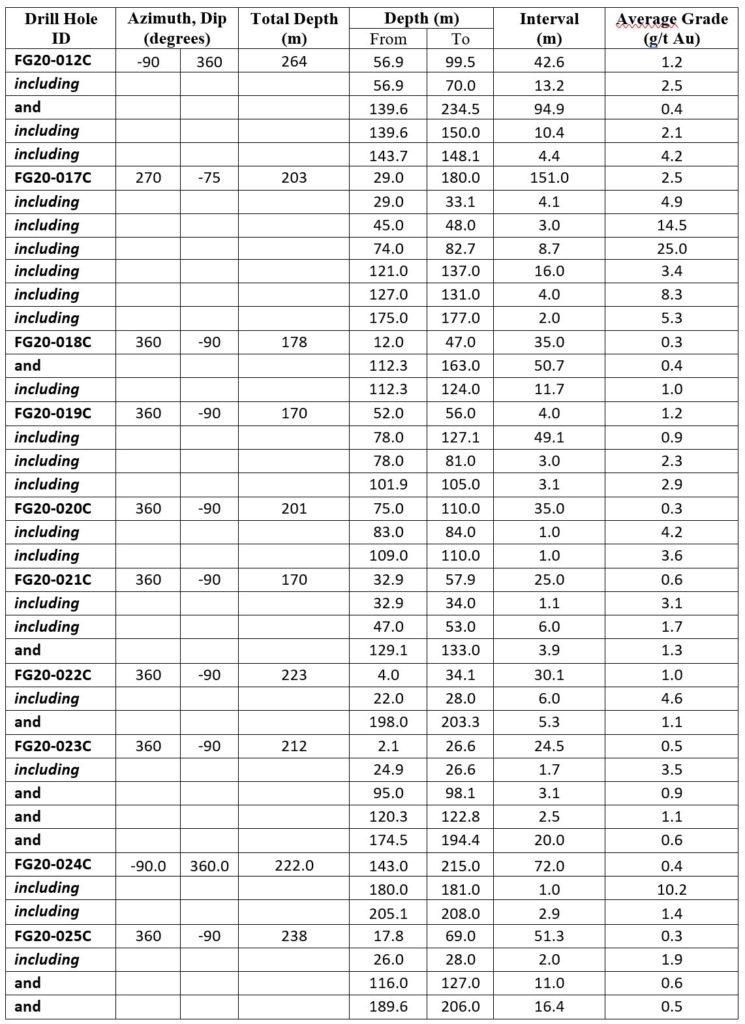- Freeman releases the highest grade intercept ever drilled at Lemhi from the remaining 20 diamond drill holes of the 2020 35-hole drill program
- Highlights include: 2.5 g/t Au over 151m, including 25 g/t Au over 8.7m (FG20-017C); 1.2 g/t Au over 42.6m (FG20-012C); 0.9 g/t Au over 72.4m, including 2.1 g/t Au over 21.1m (FG20-026C); and 1.4 g/t Au over 48.4m, including 2.1 g/t over 22m (FG20-032C)
- As a result of the 2020 drill program and increased drill density the maiden resource estimate will include drill assay results from both historical (355 holes – approx. 70,000 metres) and new drilling (35 holes – 7,200 metres)
SALMON, IDAHO– March 18, 2021 – Freeman Gold Corp. (CSE:FMAN) (FSE:3WU) (“Freeman” or the “Company”) is pleased to provide assay results of core from the remaining 20 diamond drill holes of the 35 hole 2020 program on Freeman Gold’s 100% owned Lemhi Gold Project located in Idaho. The objective of the 2020 Phase 1 drill program was designed to confirm historical mineralization and allow the use of over 355 historical drill holes in a maiden National Instrument 43-101 compliant resource estimate. The drill program focused on infill and step-out drilling within the known mineralized body to increase confidence and maximize the potential resource. The drilling completed by Freeman successfully confirmed historically defined mineralization and provided valuable infill drilling to increase confidence levels of the upcoming resource estimate.
All holes drilled to date have intersected high-grade shallow oxide gold mineralization. Drill hole FC20-017C intersected 2.5 g/t Au over 151m, representing the highest gold content in any single hole drilled at Lemhi based on a gold times core length metric (grams Au x total mineralized length = 377.5). Selected highlighted results from the 13 holes are 2.5 g/t Au over 151m, including 25 g/t Au over 8.7m (FG20-017C); 1.2 g/t Au over 42.6m (FG20-012C); 0.9 g/t Au over 72.4m, including 2.1 g/t Au over 21.1m (FG20-026C); and 1.4 g/t Au over 48.4m, including 2.1 g/t over 22m (FG20-032C).
Drill sections can be found at https://freemangoldcorp.com/wp-content/uploads/2021/03/2020-Drill-Sections-March-2021.pdf
Table 1 – Significant Drill Results


Will Randall, President & CEO, commented “the 2020 diamond drill program at Lemhi not only confirmed the vast and comprehensive historical database, but also added confidence. This gives us an excellent basis upon which to complete our maiden compliant resource estimate, with the joint objective of maximizing the resource count, increasing the resource confidence categories, and identifying areas for future growth. Our team is working on the interpretation and modelling and we will have further updates as these results come in.
Geologically, the Lemhi Gold Project lies within the Idaho-Montana porphyry belt, a northeast-trending alignment of metallic ore deposits and mines related to granitic porphyry intrusions. These extend north-easterly across Idaho and are related to the Trans-Challis fault system, a broad (20-30 km-wide) system of en-echelon northeast-trending structures extending from Boise Basin more than 270 km into Montana. At Lemhi, gold mineralization is hosted in Mesoproterozoic quartzites and phyllites within a series of relatively flat-lying lodes consisting of quartz veins, quartz stockwork and breccias and is located along the western edge of an intrusion. Mineralized lodes are associated with low angle faults, folding and shear zone(s). The mineralized zones have varying amounts of sulphides (pyrite, chalcopyrite, bornite, molybdenum, and occasionally arsenopyrite) where free gold is common. Gold mineralization at Lemhi is open at depth and on strike in all directions.
All drill core and rock samples were sent to ALS Global Laboratories (Geochemistry Division) in Vancouver, Canada, an independent and fully accredited laboratory (ISO 9001:2008) for analysis for gold by Fire Assay and multi-element Induction Coupled Plasma Spectroscopy (select drill holes). Freeman Gold has a regimented Quality Assurance, Quality Control (“QA/QC”) program where at least 10% duplicates, blanks and standards are inserted into each sample shipment. Drill hole FG20-035C was a PQ hole drilled primarily for metallurgical testing. Subsequently a portion of the samples from hole FG20-035C were analyzed at SGS Canada Inc., Burnaby, B.C., Canada, an independent and fully accredited laboratory (ISO 9001:2008) for analysis for gold by Fire Assay.
Core photos and drill sections can be found at www.freemangoldcorp.com.
The technical content of this release has been reviewed and approved by Dean Besserer, P. Geol., the VP Exploration for the Company and a Qualified Person as defined by the National Instrument 43-101.
About the Company
Freeman Gold Corp. is a mineral exploration company focused on the development of its 100% owned Lemhi Gold property (the “Lemhi Project”). The Lemhi Project comprises 30 square kilometers of highly prospective land. The mineralization at the Lemhi Project consists of shallow, near surface primarily oxide gold mineralization that has been identified from 355 historic drill holes and is open at depth and in multiple directions. The Company has completed an initial Phase 1 diamond drill program which will form the basis for a maiden NI 43-101 compliant resource estimate.
On Behalf of the Company
William Randall, President & CEO of Freeman Gold
For further information, please visit the Company’s website at www.freemangoldcorp.com or contact Mr. Ken Cotiamco at 604-687-7130 or by email at: ken@freemangoldcorp.com
Forward Looking Statements: This press release contains “forward‐looking information or statements” within the meaning of Canadian securities laws, which may include, but are not limited to statements relating to its future business plans. All statements in this release, other than statements of historical facts, that address events or developments that the Company expects to occur, are forward-looking statements. Forward-looking statements are statements that are not historical facts and are generally, but not always, identified by the words “expects”, “plans”, “anticipates”, “believes”, “intends”, “estimates”, “projects”, “potential” and similar expressions, or that events or conditions “will”, “would”, “may”, “could” or “should” occur. Although the Company believes the expectations expressed in such forward-looking statements are based on reasonable assumptions, such statements are not guarantees of future performance and actual results may differ from those in the forward-looking statements. Such forward-looking information reflects the Company’s views with respect to future events and is subject to risks, uncertainties and assumptions. The Company does not undertake to update forward‐looking statements or forward‐looking information, except as required by law.
Neither Canadian Securities Exchange nor its regulation services provider accepts responsibility for the adequacy or accuracy of this release

